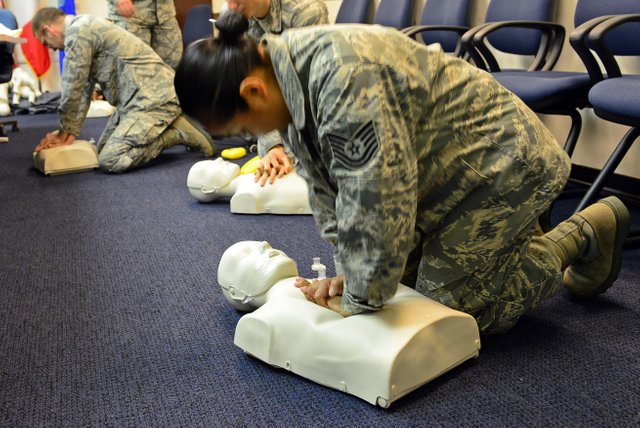Save a life, Learn CPR..
Cardiopulmonary resuscitation (CPR) is a lifesaving technique useful in many emergencies, such as Traumas, heart attack or drowning, in which someone's breathing or heartbeat has stopped. The American Heart Association recommends every witness to perform CPR while waiting for Help.
It's not unusual to witness these accidents where the victim become unconscious and his life becomes threatened.If you don't have the basic skills, the prognosis of the person can become pretty bad.
Whether you have experience or not, you need to learn the basics of CPR and teach it to the people around you.so let's get into it.
Before doing anything:
-Call 911 immediately
-Examine the place for any further danger to your life or the victim's life EX: Potential exploding car, Potential building break...remember that your life is precious and one victim is better than two
-Examine the patient: Is he conscious? unconscious ? Is there any blood loss you want to compress? Is there any penetrating object you want to avoid pulling it out (To avoid further blood loss)? NB: Always remember if the victim suffers from a spine injury don't ever try to move him!
-While waiting for 'professional help', ask anyone around for help.
The procedure :
Remember CAB ( an acronym used by The American Heart Association )
C stands for compressing
A stands for Airway
B stands for Breathing
1.Compressing:
*Sit next to the person in a comfortable position
*Place the heel of one hand over the center of the person's chest, between the nipples. Place your other hand on top of the first hand. Keep your elbows straight and position your shoulders directly above your hands.
*Push straight down on between 5 and 6 cm.Push hard at a rate of 100 compressions a minute.
*Do 30 pumps as Hard and fast as you can.
2.Airway:
*Make sure the victim airway is wide open and there's nothing suffocating him.
*For further assurance open the person's airway using the head-tilt, chin-lift maneuver. Put your palm on the person's forehead and gently tilt the head back.With the other hand, lift the chin forward to open the airway. NB: If the person suffers from a spine injury don't use this maneuver to avoid complications!
3.Breathing:
*The victim should have his head tilted and chin lifted.Now Pinch his nose and cover all of his mouth with yours and blow until you see the chest rise.If not check if the head and chin are in the right positions and repeat.
*You should do 2 breaths and Each breath should take at least 1 second.
*Resume compressions and repeat the cycle (30 Pumps-2 Breaths).
Now you should be able at least to perform a standard CPR, spread the message and save lives.
Here's a video for reference by HealthSketch
CPR For a baby:
Of course, you have to be *more* gentle with babies, CPR for infants/kids is very similar to the technique used for adults. First you have to "carefully" place your baby on his back on a flat surface, then deliver the first set of compressions but this time using only two fingers compressing his chest about 3.5cm/1.5 inches, giving two breaths after about 30 chest compressions.
All images used have been labelled for reuse on Google Images, If any image owner has an issue with this article, please contact me and I will address the issue. ' Sorry I couldn't find any CPR-Pictures on Pixabay...'
References:
https://www.mayoclinic.org/first-aid/first-aid-cpr/basics/art-20056600
http://depts.washington.edu/learncpr/quickcpr.html
Highlights of the 2015 American heart association: Guidelines Update for CPR and ECC
One more thing, Join the #steemSTEM channel, A community project to promote science technology engineering and mathematics postings on Steemit.



